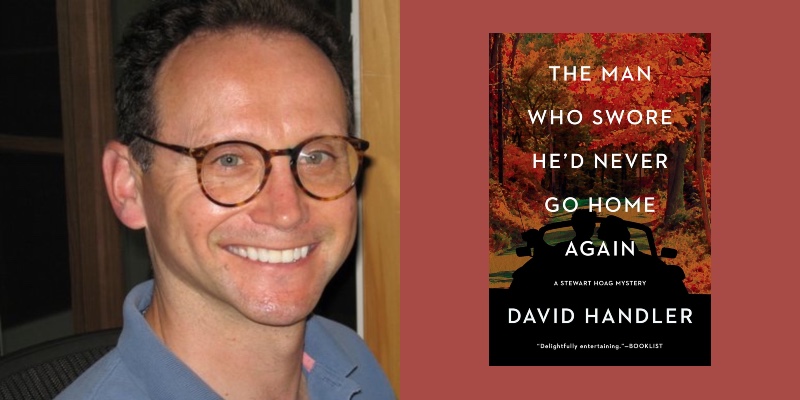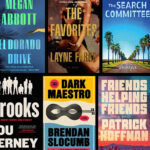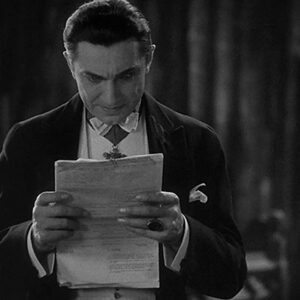Just because you think you know your characters doesn’t mean they can’t still surprise you.
David Handler will tell you as much. A former journalist and television scribe, he’s been writing about dapper if somewhat downtrodden celebrity ghostwriter and occasional PI Stewart Hoag—better known as “Hoagy”—for nearly forty years. Since launching the bestselling series with 1988’s The Man Who Died Laughing, Hoagy (and his loyal canine companion, Lulu) has appeared in sixteen novels, the newest of which, The Man Who Swore He’d Never Go Home Again (The Mysterious Press; March 18, 2025), serves as an origin story that fleshes out a history that’s only ever been hinted at.
The book finds Hoagy—who escaped an oppressive childhood in Connecticut for the freedoms of college and city life—at the pinnacle of personal and professional contentment. Having recently written a hugely successful debut novel, he has been thrust into the upper echelon of New York society. It’s at a swanky restaurant that he meets up-and-coming actress Merilee Nash; an immediate spark is lit, and not just by their obvious lust for one another but a shared aura of accomplishment and ambition. The two soon move in together and begin discussing marriage, even adopting a lovable basset hound puppy named Lulu. Only one of these relationships is destined to last.
A call from Hoagy’s first love informs him that their hometown librarian, Mary McKenna, has been murdered. Having vowed never to return to Oakmont, where his father’s broken-down brass mill still stands as a reminder of the family’s treachery, he nevertheless agrees to attend the funeral and pay his respects. After all, he credits Mrs. McKenna for channeling his teenage ambivalence into the literary aspirations that would serve as his salvation (and eventual downfall). But Hoagy’s return is rife with tensions and resentments, addiction, poverty, and sickness feeding into the poisonous venoms that plague the once thriving community. Past and present collide with the firing of a bullet, proving that while you can go home again you probably shouldn’t.
Now, David Handler reflects on the unexpectedness of flashing back to find forward momentum for Hoagy and Lulu …
John B. Valeri: The Man Who Swore He’d Never Go Home is a prequel/origin story on multiple levels – including Stewart “Hoagy” Hoag’s relationship with actress Merilee Nash and their acquisition of beloved basset hound puppy Lulu. What appealed to you about looking back into Hoagy’s history – and how does such a premise make this an ideal reading experience for both Hoagy loyalists and new readers alike?
David Handler: Once again, you’re way ahead of me, John. It never occurred to me that writing a flashback novel to the evening in 1982 when Hoagy and Merilee first set eyes on each other would serve as an ideal introductory experience for a new generation of readers who weren’t around in 1988 when I published the first of what is now sixteen books in the Edgar Award-winning Hoagy series.
When I was mulling over ideas for this book what did occur to me was that we’d never known Hoagy and Merilee when they were happy together — before he got writer’s block, got hooked on cocaine and destroyed their marriage. Had no idea how they’d met and fallen madly in love. No how idea how Princess Flavia (soon to be renamed Lulu) came into their lives. So, as a way of saying thank you to my loyal fans who’ve stuck with Hoagy for all of these years, I decided to write a flashback to their giddy whirlwind romance, which was great fun to write. Meanwhile, on a more serious note, it also occurred to me that we knew virtually nothing about Hoagy’s childhood beyond the fact that his family had owned a brass mill somewhere in Connecticut for five generations, that he detested his bully of a father and hadn’t spoken to him since he graduated from high school and went away to Harvard, where he distinguished himself by becoming the third highest-ranked javelin hurler in the entire Ivy League. By joining those two concepts together I ended up with what may be favorite novel in the entire series. I truly love this book.
JBV: Hoagy is drawn home to Oakmont, Connecticut – a place he’d vowed never to return to following his father’s betrayal of the town and its residents. In what ways does this force him to reevaluate not only his character (both then and now) but the circumstances of his departure?
DH: He hasn’t been home in eleven years and it’s a sobering experience for him. Oakmont had still been a thriving mill town when Hoagy left, with a picturesque town green surrounded by bustling locally owned businesses. While he was busy in New York City becoming what The New York Times Book Review called “the first major new literary voice of the 1980s,” Oakmont was busy becoming a ghost town. In Hoagy’s absence the family brass mill went belly up due to cheaper foreign competition. His father reneged on the health and pension benefits he’d promised non-union employees and fled to Florida, leaving tremendous ill will behind. Not to mention a whole lot of leukemia and cancer. Since one of the components of brass is lead, which is highly carcinogenic, many of the mill hands – as well as their wives and children – became fatally ill. The Oakmont River is contaminated. The town’s drinking water is contaminated. Its soil is contaminated. Unable to sell their houses, many residents abandoned them and left. Druggies live there now. Crime is rampant.
Hoagy and his father had a major falling out when he left for college because Hoagy had informed him that he refused to take his place in the family business after he graduated. He knew that that the mill was poisoning the town. All he had to do was look out his father’s office window and see the dead fish floating on the Oakmont River. His father knew it, too. He simply didn’t care. Although Hoagy has no regrets that he moved to New York to become a writer, seeing what has happened to Oakmont since he left fill him with sadness and makes him hate his father even more — although he’s about to stumble upon some deeply held secrets that will make his feelings much more complicated than he’d expected.
JBV: The catalyst for Hoagy’s homecoming is the murder of Mary McKenna – the town’s librarian (and the mother of his first love). What about Hoagy’s relationship with Mrs. McKenna compels him to return — and how does their dynamic allow for a celebration of the importance of libraries and librarians within their community?
DH: I love libraries. They’ve been my refuge since I was a little kid in Los Angeles. The faint vanilla scent of old library books still fills me with nostalgia and joy. I live in an antique carriage house in a historic Connecticut shoreline village now. My house sits a hundred yards away from the village library. I can see it right outside of my office window. I couldn’t be happier. I stop in all of the time to check out books and chat with the librarians. I love librarians. They’re smart and funny. And in a village the local library is an informal meeting place and hub of community activities.
The Oakmont Library was Hoagy’s refuge. He and his childhood best friend and eventual high school sweetheart, Maggie McKenna, spent endless hours there together seated back-to-back on the floor reading, whispering, and sneaking Snickers bars. Maggie’s mother, Mary, was the library’s director. She saw something in Hoagy that no one else saw. As the years went by, she steered him to authors like Salinger and Kerouac who she thought would inspire him. As Hoagy tells us, there is no doubt in his mind that he would never have become a novelist if it hadn’t been for Mrs. McKenna. So when Maggie phones him in New York to tell him that her mom has died he breaks his solemn promise to himself and returns home to Oakmont for her funeral. He can’t not come home for it, especially because it wasn’t leukemia that did her in. Someone murdered her.
JBV: Oakmont is a fictional mill town that has suffered the fate of so many real manufacturing communities. In what ways is this setting integral to the story at hand? And, as a longtime Connecticut resident (and former journalist), how did your own personal observations inform the narrative?
DH: As I’ve mentioned, we knew nothing about Hoagy’s childhood until now. Oakmont fills in a lot of blanks and – without giving too much away – adds a great deal of depth to his character which helps us understand how he became such an acclaimed novelist.
I gave a library talk two years ago at a beautiful little 1884 red brick library in a small former mill town 20 miles inland from my shoreline village. I’d actually never heard of the town and had to search for it on my phone. There was an old water tower on its outskirts. When I asked the librarian about the water tower she let out a laugh and told me it was actually an ink tower because there had been a paper mill there that was long gone. But not the ink tower. That became my inspiration for Oakmont. Being a former journalist, I went back there several times and explored the surrounding mill towns. One of them, Willimantic, had been home to American Thread, the largest thread manufacturer in America. They cleared out and orphaned the town, which is struggling to hang on.
JBV: Let’s talk about mackerel-loving Lulu. What have you found to be the key(s) to developing her character as a dynamic equivalent to her human counterparts? Also, how are you able to use her as an investigative tool without straining credulity?
DH: My approach toward Lulu has always been that I don’t write her as a dog. I write her as a person who doesn’t speak and has superior gifts when it comes to hearing and smell. Not to mention keen instincts when it comes to people. If she takes an instant dislike to someone there’s usually a very good reason why. She’s also allergic to a number of perfumes and sneezes any time she waddles into a room where a woman has been wearing, say, Calvin Klein’s Obsession. This can provide crucial criminal detecting help. But I have to be careful that I don’t overuse her. A little bit of Lulu goes a long way. And if I find myself straining to find a crucial role for her, I can always write her out of the book. I did that in The Man Who Cancelled Himself, when Hoagy was asked to join the sitcom writing staff of the volcanic star whose memoir he is ghosting. There were so many writers, actors, and network people in my story that there was no room for Lulu. So I gave the on-camera sitcom family a dog. The first day Lulu walks onto the set the dog attacks her. Hoagy has to gather her up and deliver her to Merilee. Problem solved.
JBV: This book finds Hoagy at the pinnacle of his profession. As a veteran of the notoriously volatile publishing industry, how did this allow you to wax poetic on the glory days? Also to what do you credit your continued motivation and success as a storyteller despite the increasing challenges of such a career?
DH: The publishing industry has changed so much since I began my career in the Eighties. Becoming a senior editor at a publishing house used to be considered a destination career. Only the most gifted and insightful made it – editors who loved to work with their authors and help them achieve their very best work. It was a personal relationship. When I delivered a new manuscript, my editor would take me out to lunch and we’d celebrate. The legendary Ruth Cavin, who was in her eighties by then, could drink me under the table. Those days are history. Over the past decade or so I’ve written novels for several different editors who I’ve not only never had lunch with but never met or even spoken to on the phone. Our entire relationship consists of emails. I miss the old days, I must confess.
The reason I’ve managed to survive as an author for as many years as I have is that I’m blessed to have a great agent, Dominick Abel. I also love to write. It’s what I do. I’ve been supporting myself as a writer of one kind or another for 45 years.
JBV: You have a background in writing comedic television. Despite the disparities in format, how has that experience lent itself to your work as a novelist? Also, what purpose(s) does humor serve in the books you write, and how do you determine whether or not it works (vs. falling flat or seeming forced)?
DH: Since I began my career as a journalist, writing sitcoms, which I began doing while I was still in my twenties, taught me a lot about creating characters and how important they are to the story. It’s your characters’ behavior that drives the story. Not what they say but what they do. I’m talking about very basic building blocks but they helped me a lot when I began trying to write a novel.
I’ve never set out to write a comic novel. I write what I think of as serious character fiction in which someone happens to die. But everything I write ends up having humor in it. I couldn’t write a book without humor if I tried. It just comes pouring out of me on its own. And that’s not such a bad thing. Humor is in awfully short supply these days, and we need it now more than ever. The real world is awfully dark and depressing.
JBV: Leave us with a teaser: What comes next?
DH: I won’t lie to you, John. I had so much fun writing The Man Who Swore He’d Never Go Home Again that the Hoagy novel I’m working on now, The Man Who Led a Dream Life, picks up three months later on the morning Hoagy and Merilee are getting married at City Hall, although their wedding day doesn’t exactly turn out the way that they’d planned.

















